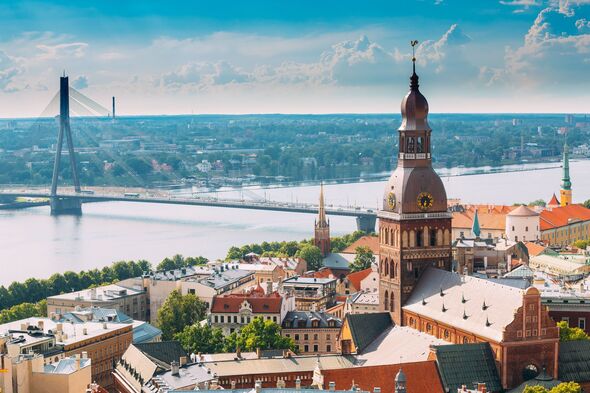World
Riga Central Market Attracts Up to 100,000 Shoppers Daily

Riga, the capital of Latvia, is gaining recognition for its vibrant market scene, with the Riga Central Market drawing between 80,000 and 100,000 visitors each day. This bustling hub is not only the largest market in Europe but also a remarkable architectural landmark, showcasing the city’s rich cultural heritage.
Situated on the banks of the Daugava River, Riga has a population of just under 600,000 people. The city features a stunning historical centre that is a designated UNESCO World Heritage Site, renowned for its Art Nouveau and Jugendstil architecture, as well as its 19th-century wooden buildings. The market itself, which has been in operation since the 16th century, offers a vast array of goods across its impressive 778,000 square feet and more than 3,000 trade stands.
Historical Significance and Architectural Features
The original market was established along the Daugava, evolving from a crowded and unsanitary outdoor venue. Between 1924 and 1930, the Riga Central Market was constructed using five pavilions built from repurposed German Zeppelin hangars. These structures, which incorporate elements of Neoclassicism and Art Deco styles, are among the last remaining Zeppelin hangars in the world.
Throughout historical upheavals, including the periods of Nazi and Soviet occupations, the market adapted and thrived. During the Soviet era, it was renamed the Central Kolkhoz Market in 1949 and became one of the largest markets in the region, serving tens of thousands of customers daily. By 1961, sales figures highlighted its significance, with the market moving approximately 200,000 metric tons of poultry, 768,000 litres of milk, and over 22,000 metric tons of fruits and vegetables each year.
Modern Developments and Challenges
The market has undergone significant renovations, including the reopening of the Gastronomy Pavilion in January 2019, following a closure since autumn 2016. The renovation cost around €1.7 million (approximately £1.5 million). Despite its ongoing popularity, the market faces challenges from the rise of supermarkets, prompting the city council to prioritize its cultural significance and mission.
Visitors to Riga often include the market on their itinerary, along with other notable sites such as the Freedom Monument, St. Peter’s Church, and the House of the Blackheads. These landmarks contribute to the city’s charm, with one recent visitor describing Riga as a “magical architecture and charming streets” that feels like a fairy tale.
Direct flights to Riga International Airport (RIX) are available from several UK airports, including Gatwick, Stansted, Manchester, and Glasgow, with an average flight time of under three hours. According to Skyscanner, September is the most economical month to visit, featuring direct flights as low as £19 on Ryanair from Stansted.
Riga, with its stunning architecture, rich history, and bustling market, invites visitors to explore its vibrant culture and welcoming atmosphere. As it continues to thrive, the Riga Central Market remains a testament to the city’s resilience and charm.
-

 Health3 months ago
Health3 months agoNeurologist Warns Excessive Use of Supplements Can Harm Brain
-

 Health3 months ago
Health3 months agoFiona Phillips’ Husband Shares Heartfelt Update on Her Alzheimer’s Journey
-

 Science1 month ago
Science1 month agoBrian Cox Addresses Claims of Alien Probe in 3I/ATLAS Discovery
-

 Science1 month ago
Science1 month agoNASA Investigates Unusual Comet 3I/ATLAS; New Findings Emerge
-

 Science4 weeks ago
Science4 weeks agoScientists Examine 3I/ATLAS: Alien Artifact or Cosmic Oddity?
-

 Science4 weeks ago
Science4 weeks agoNASA Investigates Speedy Object 3I/ATLAS, Sparking Speculation
-

 Entertainment4 months ago
Entertainment4 months agoKerry Katona Discusses Future Baby Plans and Brian McFadden’s Wedding
-

 Entertainment4 months ago
Entertainment4 months agoEmmerdale Faces Tension as Dylan and April’s Lives Hang in the Balance
-

 World3 months ago
World3 months agoCole Palmer’s Cryptic Message to Kobbie Mainoo Following Loan Talks
-

 Science4 weeks ago
Science4 weeks agoNASA Scientists Explore Origins of 3I/ATLAS, a Fast-Moving Visitor
-

 Entertainment4 months ago
Entertainment4 months agoLove Island Star Toni Laite’s Mother Expresses Disappointment Over Coupling Decision
-

 Entertainment3 months ago
Entertainment3 months agoMajor Cast Changes at Coronation Street: Exits and Returns in 2025









